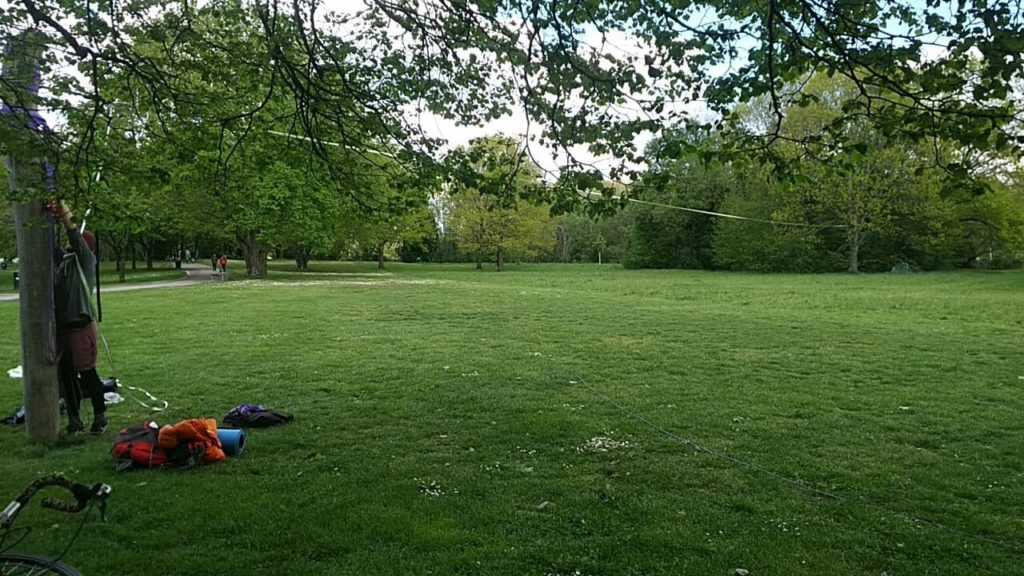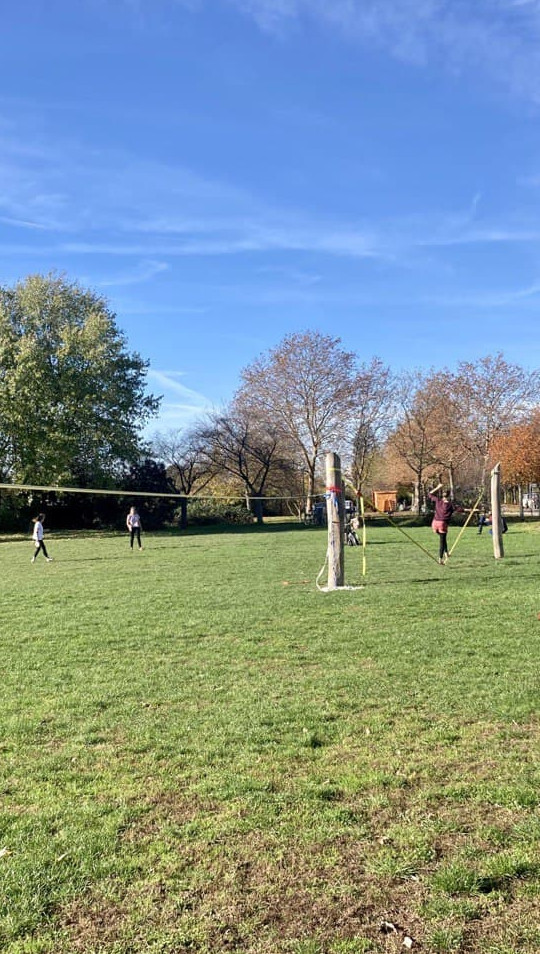Slacklining - what is it about?
Slacklining is balancing on a 2 to 5 cm wide webbing. Basically simple, but full of variations and space for creativity, always new challenges and fun: Longline (long), Rodeoline (saggy), Waterline (over water), Trickline (strongly tensioned for jumping), Speedline (on time), static and dynamic tricks, freestyle, blind walking, tandem (in pairs), …
In a highlining (or if less high also called midline) the slackline is rigged at a great height over ravines between rocks, trees or houses. The athletes are secured with a safety rope (“leash”) and climbing harness, which makes the sport very close to climbing. In addition to athletic skills and concentration, the technical knowledge and team spirit while rigging also play a major role.

Spots for slacklining in Freiburg
The most common places to see slacklines in Freiburg are probably Eschholzpark, Seepark and Dietenbachpark. There you can find facilities for lines between approx. 8 and 20 m long, as well as good spots for longer lines (always use effective tree protection).
For our highline and trickline training we are still looking for suitable spots in and around the city.
Tree protection
When slacklining between trees, please always use an effective tree protector, so that the trees in our favorite parks remain intact and our sport continues to be accepted in the city!
A wide and robust tree protector protects the bark from abrasion and the slings from rapid wear. These are available for purchase in a convenient format with felt set-up aids, but carpet scraps, thick towels, sleeping mats, or the like can also be used.
In addition to external abrasion, tree protection is also about protecting the tree from having its water transport systems cut off. Wide slings (about 5 cm) and the tree protector help to distribute the pressure. Especially in the spring, when the trees carry a lot of liquid in the trunk, and in the case of long-term installation in the garden, care should be taken that the slings do not strangle the trunk all around. For this purpose, it is recommended to set up the slings so that one side of the trunk remains free or to place narrow slats or sticks vertically between the bark and the sling, as is also practiced in permanent installations of adventure parks.
As a general rule, only set up the slackline on healthy trees with a trunk diameter of approx. 30 cm, so that they can withstand the tensile load of a slackline. The forces acting on the line are particularly dependent on the tension, whereby a loose rodeoline represents a lower load than a strongly tensioned trickline.
Safety
A few safety precautions can help prevent accidents while slacklining. We have summarized the most important points that need to be taken into account, especially for long and strongly tensioned lines, where large forces are at work. Detailed instructions on how to set up a backup and more detailed information on the subject of safety when slacklining can be found in the publications of the International Slackline Association (ISA) linked below.
- Take care about visibility of your lines and do not rig over paths and make sure that other people keep a safe distance, nobody grabs the line or climbs over it and especially keep an eye on children.
- Always check your ratchets to be closed properly.
- Tie back all metal parts (ratchets, weblocks, shackles) to the tree or pole. For short lines, you can use the remaining webbing as backup. For lines under greater tension (tricklines and longlines), use an additional backup rope to prevent them from becoming projectiles in the event of line or sling failure.
- Do not use aluminium climbing carabiners to set up your slackline. Cyclic loadings while slacklining fatigue the material and can cause sudden breaks. Use oval steel biners instead and in case of triloadings (forces in three directions as when connecting tree slings and line) use shackles.

